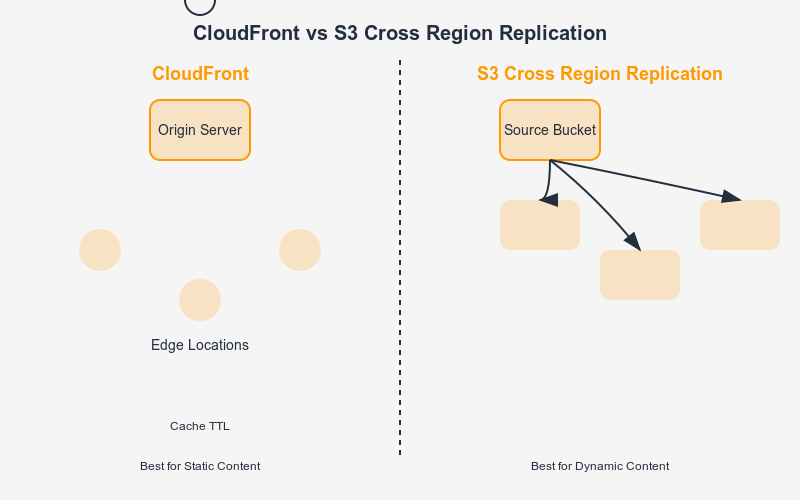CloudFront vs. S3 Cross Region Replication: Choosing the Right Solution for Your Content Delivery Needs
 Gedion Daniel
Gedion Daniel
When it comes to delivering content in the cloud, two powerful solutions from AWS stand out: CloudFront and S3 Cross Region Replication. Each has its unique strengths and is suited for different types of content delivery. In this post, I’ll break down the key features of both options to help you determine which one fits your needs best.
CloudFront: The Global Edge Network
Amazon CloudFront is a content delivery network (CDN) that leverages a global edge network to deliver content with low latency. Here are some of its key features:
Global Edge Network: CloudFront has numerous edge locations worldwide, which means it can deliver your content closer to users, reducing the time it takes for them to access it. When a user requests a file, CloudFront serves it from the nearest edge location, ensuring faster load times.
File Caching and TTL: CloudFront caches files at its edge locations for a specified time, known as Time to Live (TTL). This caching can be set to various durations (often up to a day) depending on how frequently the content changes. For static content, this is incredibly efficient, as repeated requests for the same file will be served from the cache, reducing the load on your origin servers.
Best for Static Content: CloudFront is ideal for serving static files such as images, videos, CSS, and JavaScript. If your application relies heavily on static assets that need to be available globally, CloudFront is an excellent choice.
S3 Cross Region Replication: Real-Time Data Availability
On the other hand, S3 Cross Region Replication is designed to automatically replicate objects from one S3 bucket to another in different regions. Here’s how it stands out:
Region-Specific Setup: Unlike CloudFront, which operates globally by design, S3 Cross Region Replication must be explicitly set up for each target region where you want your data to be replicated. This gives you control over where your data resides, which can be useful for compliance or latency considerations.
Near Real-Time Updates: S3 Cross Region Replication updates files in near real-time. Whenever an object is created or updated in the source bucket, the changes are replicated to the destination bucket almost immediately. This ensures that users in different geographic locations have access to the most current version of your data.
Read-Only Access: Once replicated, the objects in the target S3 bucket are read-only. This means that while users can access the latest data, they cannot modify it directly in the replicated bucket. This is beneficial for maintaining data integrity across regions.
Ideal for Dynamic Content: If your application serves dynamic content that requires low-latency access, S3 Cross Region Replication is a better choice. This setup allows you to have your data closer to users in different regions, reducing the time it takes to retrieve that data.
Choosing the Right Solution
So, which option should you choose? Here are some considerations based on your specific needs:
Type of Content:
If you primarily serve static content like images or videos that don’t change often, CloudFront is likely your best bet. It will reduce load times and improve user experience through its caching capabilities.
For dynamic content that changes frequently or requires users to access the most current data, S3 Cross Region Replication would be more suitable, as it keeps your data up-to-date across regions.
Geographic Reach:
CloudFront excels in delivering content globally with minimal latency thanks to its extensive network of edge locations. If your user base is widespread, this is a critical advantage.
If you need specific regions for data residency or compliance, S3 Cross Region Replication gives you control over where your data is stored while still providing low-latency access.
Cost Considerations:
- Both services have associated costs, but CloudFront charges for data transfer out from edge locations, while S3 Cross Region Replication incurs charges for data transferred between regions. Analyzing your data transfer needs can help you choose the more cost-effective solution.
Subscribe to my newsletter
Read articles from Gedion Daniel directly inside your inbox. Subscribe to the newsletter, and don't miss out.
Written by

Gedion Daniel
Gedion Daniel
I am a Software Developer from Italy.